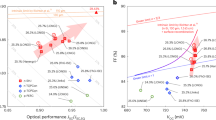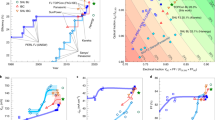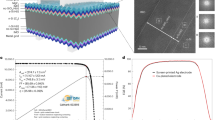Abstract
For crystalline-silicon solar cells, voltages close to the theoretical limit are nowadays readily achievable when using passivating contacts. Conversely, maximal current generation requires the integration of the electron and hole contacts at the back of the solar cell to liberate its front from any shadowing loss. Recently, the world-record efficiency for crystalline-silicon single-junction solar cells was achieved by merging these two approaches in a single device; however, the complexity of fabricating this class of devices raises concerns about their commercial potential. Here we show a contacting method that substantially simplifies the architecture and fabrication of back-contacted silicon solar cells. We exploit the surface-dependent growth of silicon thin films, deposited by plasma processes, to eliminate the patterning of one of the doped carrier-collecting layers. Then, using only one alignment step for electrode definition, we fabricate a proof-of-concept 9-cm2 tunnel-interdigitated back-contact solar cell with a certified conversion efficiency >22.5%.
This is a preview of subscription content, access via your institution
Access options
Access Nature and 54 other Nature Portfolio journals
Get Nature+, our best-value online-access subscription
$29.99 / 30 days
cancel any time
Subscribe to this journal
Receive 12 digital issues and online access to articles
$119.00 per year
only $9.92 per issue
Buy this article
- Purchase on Springer Link
- Instant access to full article PDF
Prices may be subject to local taxes which are calculated during checkout




Similar content being viewed by others
References
Jäger-Waldau, A. PV Status Report 2016. JRC Science for Policy Report (Publications Office of the European Union, 2016).
Battaglia, C., Cuevas, A. & De Wolf, S. High-efficiency crystalline silicon solar cells: status and perspectives. Energy Environ. Sci. 9, 1552–1576 (2016).
International Energy Agency 2015 Snapshot of Global Photovoltaic Markets (International Energy Agency Photovoltaic Power System Programme (IEA PVPS), 2016); http://www.iea-pvps.org/fileadmin/dam/public/report/PICS/IEA-PVPS_-__A_Snapshot_of_Global_PV_-_1992-2015_-_Final_2_02.pdf
Powell, D. M. et al. Crystalline silicon photovoltaics: a cost analysis framework for determining technology pathways to reach baseload electricity costs. Energy Environ. Sci. 5, 5874–5883 (2012).
Green, M. A. Commercial progress and challenges for photovoltaics. Nat. Energy 1, 15015 (2016).
Glunz, S. W. et al. The irresistible charm of a simple current flow pattern — 25% with a solar cell featuring a full-area back contact. In Proc. 31st Eur. Photovoltaic Solar Energy Conf. Exhib. (EUPVSEC) 259–263 (WIP, Renewable Energies, 2015).
Adachi, D., Hernández, J. L. & Yamamoto, K. Impact of carrier recombination on fill factor for large area heterojunction crystalline silicon solar cell with 25.1% efficiency. Appl. Phys. Lett. 107, 233506 (2015).
Aleman, M. et al. Development and integration of a high efficiency baseline leading to 23% IBC cells. Energy Procedia 27, 638–645 (2012).
Peibst, R. et al. High-efficiency RISE-IBC solar cells: influence of rear side-passivation on pn-junction meander recombination. In Proc. 28th Eur. Photovoltaic Solar Energy Conf. Exhib. (EUPVSEC) 971–975 (WIP, Renewable Energies, 2013).
Reichel, C., Granek, F., Hermle, M. & Glunz, S. W. Back-contacted back-junction n-type silicon solar cells featuring an insulating thin film for decoupling charge carrier collection and metallization geometry. Prog. Photovolt. Res. Appl. 21, 1063–1076 (2013).
Savin, H. et al. Black silicon solar cells with interdigitated back-contacts achieve 22.1% efficiency. Nat. Nanotech. 10, 624–628 (2015).
Franklin, E. et al. Design, fabrication and characterisation of a 24.4% efficient interdigitated back contact solar cell. Prog. Photovolt. Res. Appl. 24, 411–427 (2016).
Green, M. A., Emery, K., Hishikawa, Y., Warta, W. & Dunlop, E. D. Solar cell efficiency tables (version 48). Prog. Photovolt. Res. Appl. 24, 905–913 (2016).
Mingirulli, N. et al. Efficient interdigitated back-contacted silicon heterojunction solar cells. Phys. Status Solidi 5, 159–161 (2011).
Lee, S.-Y. et al. Analysis of a-Si:H/TCO contact resistance for the Si heterojunction back-contact solar cell. Sol. Energy Mater. Sol. Cells 120A, 412–416 (2014).
Paviet-Salomon, B. et al. Back-contacted silicon heterojunction solar cells: optical-loss analysis and mitigation. IEEE J. Photovolt. 5, 1293–1303 (2015).
Zhang, L. et al. Experimental and simulated analysis of p a-Si:H defects on silicon heterojunction solar cells: trade-offs between Voc and FF. In Proc. 42nd IEEE Photovoltaic Specialist Conf. (PVSC) 1–5 (IEEE, 2015).
Xu, M. et al. Process development of silicon heterojunction interdigitated back-contacted (SHJ-IBC) solar cells bonded to glass. In Proc. 32nd Eur. Photovoltaic Solar Energy Conf. Exhib. (EUPVSEC) 328–330 (2016).
Yang, G., Ingenito, A., Isabella, O. & Zeman, M. IBC c-Si solar cells based on ion-implanted poly-silicon passivating contacts. Sol. Energy Mater. Sol. Cells 158, 84–90 (2016).
Harrison, S. et al. Back contact heterojunction solar cells patterned by laser ablation. Energy Procedia 92, 730–737 (2016).
Rienäcker, M. et al. Junction resistivity of carrier-selective polysilicon on oxide junctions and its impact on solar cell performance. IEEE J. Photovolt. 7, 11–18 (2017).
Chunduri, S. Solar research institute ISFH attains 25% cell efficiency with POLO contacts approach in combination with backcontact architecture. TaiyangNews (10 February 2017); http://taiyangnews.info/technology/25-polo-solar-cell-from-isfh
Smith, D. D. et al. Toward the practical limits of silicon solar cells. IEEE J. Photovolt. 4, 1465–1469 (2014).
Masuko, K. et al. Achievement of more than 25% conversion efficiency with crystalline silicon heterojunction solar cell. IEEE J. Photovolt. 4, 1433–1435 (2014).
Nakamura, J. et al. Development of heterojunction back contact Si solar cells. IEEE J. Photovolt. 4, 1491–1495 (2014).
Yoshikawa, K. et al. Silicon heterojunction solar cell with interdigitated back contacts for a photoconversion efficiency over 26%. Nat. Energy 2, 17032 (2017).
De Wolf, S., Descoeudres, A., Holman, Z. C. & Ballif, C. High-efficiency silicon heterojunction solar cells: a review. Green 2, 7–24 (2012).
Best Research-Cell Efficiencies (NREL, 2016); http://www.nrel.gov/pv/assets/images/efficiency_chart.jpg
Richter, A., Hermle, M. & Glunz, S. W. Reassessment of the limiting efficiency for crystalline silicon solar cells. IEEE J. Photovolt. 3, 1184–1191 (2013).
Esaki, L. New phenomenon in narrow germanium p-n junctions. Phys. Rev. 109, 603–604 (1958).
Kobayashi, E. et al. Light-induced performance increase of silicon heterojunction solar cells. Appl. Phys. Lett. 109, 153503 (2016).
Spee, D. A. Preparations for Making Back Contacted Heterojunction Solar Cells. MSc thesis, Utrecht University (2008).
Herasimenka, S. Y., Tracy, C. J., Dauksher, W. J., Honsberg, C. B. & Bowden, S. A simplified process flow for silicon heterojunction interdigitated back contact solar cells: using shadow masks and tunnel junctions. In Proc. 40th IEEE Photovoltaic Specialist Conf. (PVSC) 2486–2490 (2014).
Lu, M., Bowden, S., Das, U. & Birkmire, R. Interdigitated back contact silicon heterojunction solar cell and the effect of front surface passivation. Appl. Phys. Lett. 91, 063507 (2007).
Hermle, M., Granek, F., Schultz-Wittmann, O. & Glunz, S. W. Shading effects in back-junction back-contacted silicon solar cells. In Proc. 33rd IEEE Photovoltaic Specialist Conf. (PVSC) 1–4 (2008).
Tomasi, A. et al. Back-contacted silicon heterojunction solar cells with efficiency >21%. IEEE J. Photovolt. 4, 1046–1054 (2014).
Amano, C., Sugiura, H., Yamamoto, A. & Yamaguchi, M. 20.2% efficiency Al0.4Ga0.6As/GaAs tandem solar cells grown by molecular beam epitaxy. Appl. Phys. Lett. 51, 1998–2000 (1987).
Meier, J. et al. The ‘Micromorph’ solar cells: a new way to high efficiency thin film silicon solar cells. In Proc. 13th Eur. Photovoltaic Solar Energy Conf. Exhib. (EUPVSEC) 1445–1450 (1995).
Schüttauf, J.-W. et al. Amorphous silicon–germanium for triple and quadruple junction thin-film silicon based solar cells. Sol. Energy Mater. Sol. Cells 133, 163–169 (2015).
Essig, S. et al. Wafer-bonded GaInP/GaAs//Si solar cells with 30% efficiency under concentrated sunlight. IEEE J. Photovolt. 5, 977–981 (2015).
Mailoa, J. P. et al. A 2-terminal perovskite/silicon multijunction solar cell enabled by a silicon tunnel junction. Appl. Phys. Lett. 106, 121105 (2015).
Werner, J. et al. Efficient monolithic perovskite/silicon tandem solar cell with cell area >1 cm2. J. Phys. Chem. Lett. 7, 161–166 (2016).
Fujiwara, H. & Kondo, M. Effects of a-Si:H layer thicknesses on the performance of a-Si:H/c-Si heterojunction solar cells. J. Appl. Phys. 101, 054516 (2007).
Tomasi, A. Back-Contacted Silicon Heterojunction Solar Cells. PhD dissertation, École polytechnique fédérale de Lausanne (2016).
Tomasi, A. et al. Photolithography-free interdigitated back-contacted silicon heterojunction solar cells with efficiency >21%. In Proc. 40th IEEE Photovoltaic Specialist Conf. (PVSC) 3644–3648 (2014).
Ledinský, M. et al. Profilometry of thin films on rough substrates by Raman spectroscopy. Sci. Rep. 6, 37859 (2016).
Wurfel, U., Cuevas, A. & Wurfel, P. Charge carrier separation in solar cells. IEEE J. Photovolt. 5, 461–469 (2015).
Brendel, R. & Peibst, R. Contact selectivity and efficiency in crystalline silicon photovoltaics. IEEE J. Photovolt. 6, 1413–1420 (2016).
Tomasi, A. et al. Transparent electrodes in silicon heterojunction solar cells: influence on contact passivation. IEEE J. Photovolt. 6, 17–27 (2016).
Rößler, R., Leendertz, C., Korte, L., Mingirulli, N. & Rech, B. Impact of the transparent conductive oxide work function on injection-dependent a-Si:H/c-Si band bending and solar cell parameters. J. Appl. Phys. 113, 144513 (2013).
Sze, S. M. & Ng, K. K. Physics of Semiconductor Devices 3rd edn (John Wiley, 2006).
Alpuim, P., Chu, V. & Conde, J. P. Doping of amorphous and microcrystalline silicon films deposited at low substrate temperatures by hot-wire chemical vapor deposition. J. Vac. Sci. Technol. A 19, 2328–2334 (2001).
Strahm, B., Howling, A. A., Sansonnens, L. & Ch, H. Plasma silane concentration as a determining factor for the transition from amorphous to microcrystalline silicon in SiH4/H2 discharges. Plasma Sources Sci. Technol. 16, 80–89 (2007).
Seif, J. P. et al. Strategies for doped nanocrystalline silicon integration in silicon heterojunction solar cells. IEEE J. Photovolt. 6, 1132–1140 (2016).
Nogay, G. et al. Nanocrystalline silicon carrier collectors for silicon heterojunction solar cells and impact on low-temperature device characteristics. IEEE J. Photovolt. 6, 1654–1662 (2016).
Demaurex, B. et al. Low-temperature plasma-deposited silicon epitaxial films: growth and properties. J. Appl. Phys. 116, 053519 (2014).
Koh, J., Lee, Y., Fujiwara, H., Wronski, C. R. & Collins, R. W. Optimization of hydrogenated amorphous silicon p–i–n solar cells with two-step i layers guided by real-time spectroscopic ellipsometry. Appl. Phys. Lett. 73, 1526–1528 (1998).
Collins, R. W. et al. Evolution of microstructure and phase in amorphous, protocrystalline, and microcrystalline silicon studied by real time spectroscopic ellipsometry. Sol. Energy Mater. Sol. Cells 78, 143–180 (2003).
Cabarrocas, P. R. I., Layadi, N., Heitz, T., Drévillon, B. & Solomon, I. Substrate selectivity in the formation of microcrystalline silicon: mechanisms and technological consequences. Appl. Phys. Lett. 66, 3609–3611 (1995).
Bullock, J. et al. Efficient silicon solar cells with dopant-free asymmetric heterocontacts. Nat. Energy 1, 15031 (2016).
Yang, X. et al. High-performance TiO2-based electron-selective contacts for crystalline silicon solar cells. Adv. Mater. 28, 5891–5897 (2016).
Wan, Y. et al. Magnesium fluoride electron-selective contacts for crystalline silicon solar cells. ACS Appl. Mater. Interfaces 8, 14671–14677 (2016).
Gogolin, R. et al. Analysis of series resistance losses in a-Si:H/c-Si heterojunction solar cells. IEEE J. Photovolt. 4, 1169–1176 (2014).
Tatsuro, W. et al. Rear-emitter Si heterojunction solar cells with over 23% efficiency. Appl. Phys. Exp. 8, 021402 (2015).
Römer, U. et al. Recombination behavior and contact resistance of n+ and p+ poly-crystalline Si/mono-crystalline Si junctions. Sol. Energy Mater. Sol. Cells 131, 85–91 (2014).
Teplin, C. W. et al. Breakdown physics of low-temperature silicon epitaxy grown from silane radicals. Phys. Rev. B 74, 235428 (2006).
Teplin, C. W., Jiang, C.-S., Stradins, P. & Branz, H. M. Cone kinetics model for two-phase film silicon deposition. 92, 093114 (2008).
Khanna, A. et al. A fill factor loss analysis method for silicon wafer solar cells. IEEE J. Photovolt. 3, 1170–1177 (2013).
Wan, Y., Yan, D., Bullock, J., Zhang, X. & Cuevas, A. Passivation of c-Si surfaces by sub-nm amorphous silicon capped with silicon nitride. Appl. Phys. Lett. 107, 231606 (2015).
Holman, Z. C., Descoeudres, A., De Wolf, S. & Ballif, C. Record infrared internal quantum efficiency in silicon heterojunction solar cells with dielectric/metal rear reflectors. IEEE J. Photovolt. 3, 1243–1249 (2013).
Adachi, D., Hernández, J. L. & Yamamoto, K. Impact of carrier recombination on fill factor for large area heterojunction crystalline silicon solar cell with 25.1% efficiency. Appl. Phys. Lett. 107, 233506 (2015).
Geissbühler, J. et al. 22.5% efficient silicon heterojunction solar cell with molybdenum oxide hole collector. Appl. Phys. Lett. 107, 081601 (2015).
Sakai, Y., Fukuyama, K., Matsumura, M., Nakato, Y. & Tsubomura, H. The effect of interposing thin oxide layers on the photovoltaic properties of a-Si:H solar cells II between the middle n and p layers of a tandem-type cell. J. Appl. Phys. 64, 394–398 (1988).
Demaurex, B., De Wolf, S., Descoeudres, A., Charles Holman, Z. & Ballif, C. Damage at hydrogenated amorphous/crystalline silicon interfaces by indium tin oxide overlayer sputtering. Appl. Phys. Lett. 101, 171604 (2012).
Acknowledgements
This work was supported by the Swiss Commission for Technology and Innovation (CTI) by the Swiss Federal Office for Energy (SFOE), and by the Fonds National Suisse Reequip Program. The authors thank Meyer Burger Research for scientific partnership and financial support; D. Lachenal and B. Strahm for support and collaboration in back-contacted silicon heterojunction solar-cell development; J. Hermans and Meyer Burger B.V. for the support in inkjet printing; M. Pickrell and SunChemicals for supplying the hot melt; the Academic Writing Services at KAUST for text editing; M. J. Lehmann, N. Badel and H. Watanabe at EPFL and CSEM for their support in back-end processing; and A. Hessler at EPFL and CIME for the TEM observations.
Author information
Authors and Affiliations
Contributions
A.T., B.P.-S., M.D. and C.B. conceived the idea. A.T. designed the experiments and carried out the device fabrication in collaboration with B.P.-S. Q.J. carried out the TEM observations. L.B. and A.D. developed the a-Si:H(i) passivating films. J.P.S. contributed to the development of the doped Si:H thin-film materials. S.N. and G.C. developed and deposited the TCO material. J.H. and S.D.W. contributed to the definition and presentation of the paper contents. S.D.W., M.D. and C.B. discussed the results and organized the research. A.T. wrote the paper, and all other authors provided feedback.
Corresponding author
Ethics declarations
Competing interests
The authors declare no competing financial interests.
Supplementary information
Supplementary Information
Supplementary Notes 1–5, Supplementary Figures 1–6, Supplementary Tables 1–5, Supplementary References. (PDF 1689 kb)
Rights and permissions
About this article
Cite this article
Tomasi, A., Paviet-Salomon, B., Jeangros, Q. et al. Simple processing of back-contacted silicon heterojunction solar cells using selective-area crystalline growth. Nat Energy 2, 17062 (2017). https://doi.org/10.1038/nenergy.2017.62
Received:
Accepted:
Published:
DOI: https://doi.org/10.1038/nenergy.2017.62
This article is cited by
-
Triple-layered nc-Si:H films improve electrical properties and expand process window of IBC-SHJ solar cells simulated by Silvaco TCAD
Science China Materials (2023)
-
Status and perspectives of crystalline silicon photovoltaics in research and industry
Nature Reviews Materials (2022)
-
Electronic structure analysis of a-Si: H p-i1-i2-n solar cells using ellipsometry spectroscopy
Optical and Quantum Electronics (2022)
-
Simulation-based roadmap for the integration of poly-silicon on oxide contacts into screen-printed crystalline silicon solar cells
Scientific Reports (2021)
-
Still in the game
Nature Energy (2021)



